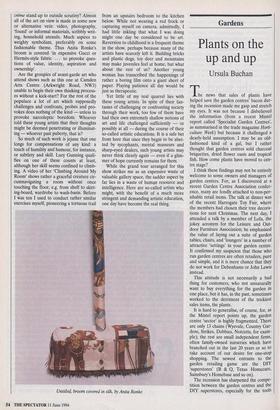Exhibitions
ST New Contemporaries (Camden Arts Centre, till 12 June)
Telecom
it faut
Giles Auty
Although the exhibition described here closes this Sunday in London, it moves on thereafter in semi-regal progress to Manchester (Cornerhouse 18 June – 24 July), Bristol (Arnolfini 6 August – 21 September), Edinburgh (Fruitmarket 3 October – 6 November), Aberystwyth (Arts Centre 29 January – 12 March) and Brad- ford (18 March – 15 May). By this last date, it will have been on view somewhere or other in publicly subsidised art galleries in Britain for slightly over a year.
What does the show purport to be? To quote David Manley, current chair of New Contemporaries: 'The exhibition makes only one claim, though a daunting one, that of showcasing some of the very best new work being made.' In fact, the exhibition repre- sents the work of 36 students and recent graduates from British art schools, selected from an initial submission of 1,200 applica- tions by a committee of three which includes .last year's winner of the Turner Prize, Rachel Whiteread. Roughly a quar- ter of those finally chosen attended at some point in their careers that much- vaunted headquarters of alternative art teaching, Goldsmith's College. Here Mike Bowtell, Head of Corporate Affairs at BT, tries to make what seems a fairly crass jus- tification for BT's sponsorship of such manifestations: 'In keeping with our posi- tion as a leading edge, technology-driven company our arts programme has been dis- tinguished by its commitment to innovation and communication.'
The myth that some umbilical or other- wise valid connection exists between technological progress and supposed artis- tic advance is one of the less defensible clichés of our age. Lewis Mumford, for one, demolished it utterly all of 30 years ago in The Pentagon of Power, yet it contin- ues to be trotted out. The worthlessness of much of the artistic innovation we have witnessed in the three decades intervening might have prompted slightly more caution on the part of BT's spokesman when mak- ing his comparisons. But then when have the utterances of corporate affairs depart- ments been noted for acuity of thought?
So to the show itself and the work of the 3 per cent chosen from the original submis- sion. How does the apparent creme de la creme stand up to outside scrutiny? Almost all of the art on view is made in some new or alternative vein: video, photography, `found' or informal materials, scribbly writ- ing, household utensils. Much aspires to weighty symbolism, preferably on some fashionable theme. Thus Anita Ronke's broom is covered 'in expensive Gucci or Hermes-style fabric .. . to provoke ques- tions of value, identity, aspiration and ownership'.
Are the groupies of avant-garde art who attend shows such as this one at Camden Arts Centre (Arkwright Road, NW3) unable to begin their own thinking process- es without a kick-start? For the rest of the populace a lot of art which supposedly challenges and confronts, probes and pro- vokes does nothing of the kind — unless to provoke narcoleptic boredom. Whoever told these young artists that their thoughts might be deemed penetrating or illuminat- ing — whoever past puberty, that is?
So much of such work is jejune that one longs for compensations of any kind: a touch of humility and humour, for instance, or subtlety and skill. Lucy Gunning quali- fies on one of these counts at least, although her skill seems confined to climb- ing. A video of her 'Climbing Around My Room' shows rather a graceful creature cir- cumnavigating a room without once touching the floor, e.g. from shelf to skirt- ing-board, wardrobe to wash-basin. Before I was ten I used to conduct rather similar exercises myself, pioneering a tortuous trail from an upstairs bedroom to the kitchen below. While not wearing a red frock or capturing myself on camera, admittedly, I had little inkling that what I was doing might one day be considered to be art. Reversion to childhood is a frequent theme in the show, perhaps because many of the artists have scarcely left it. Building bricks and plastic dogs, toy deer and mountains may make juveniles feel at home, but what about the rest of us? Another young woman has transcribed the happenings of rather a boring film onto a giant sheet of paper. Playing patience all day would be just as therapeutic.
Yet little of my real quarrel lies with these young artists. In spite of their fan- tasies of challenging or confronting society through their work, too few of them have had their own extremely shallow notions of art and life challenged sufficiently — or possibly at all — during the course of their so-called artistic educations. It is a safe bet from here that once they begin to be abet- ted by sycophants, mental masseurs and sharp-eyed dealers, such young artists may never think clearly again — even if a glim- mer of hope currently remains for them.
While the grand tour arranged for this show strikes me as an expensive waste of valuable gallery space, the sadder aspect by far lies in a waste of human resource and intelligence. Here are so-called artists who might, with the benefit of a much more stringent and demanding artistic education, one day have become the real thing.
Untitled, broom covered in silk, by Anita Ronke



































































 Previous page
Previous page